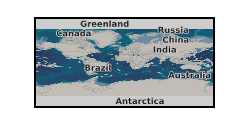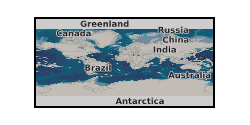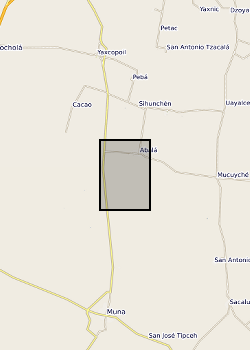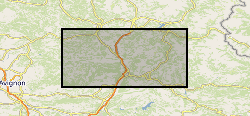Oxygen isotopes
Type of resources
Topics
Keywords
Contact for the resource
Provided by
Years
Formats
Representation types
Update frequencies
-

Data collected from IODP Expedition 353, Site U1446. Data represent ISM derived rainfall and runoff proxies across Termination II. Mid-depth on CCSFA scale. Two age columns derived from age models based on LR04 benthic oxygen isotope record and AICC2012 chronology. Sheet 2 include Globigerinoides ruber sensu-stricto oxygen isotope data, Mg/Ca, Mn/Ca, U/Ca and Nd/Ca Sheet 3 include discrete portable X-Ray Fluorescence data for Ti, Al, K and Rb.
-

Provided here are in-situ Si and O isotope compositions of Detrital Jack Hills and Lachlan Fold Belt zircons. These data formed the basis of the research published as: Origin and significance of Si and O isotope heterogeneities in Phanerozoic, Archean, and Hadean zircon, Trail et al., (2018), PNAS 115 (41), 10287-10292 The data are provided in a single Excel spreadsheet, with multiple tabs, which are as follows: 1. Sample description and analytical method summaries 2. Solution and laser-fluorination data for characterisation of the standards used in the Ion Probe measurement sessions 3. Ion Probe (In-situ) Si and O isotope data for the Lachlan Fold Belt and Duluth Gabbro zircons 4. Ion Probe (In-situ) Si and O isotope data for the detrital Jack Hills zircons, as well as 207Pb/206Pb age estimates 5. Raw Ion Probe Si and O isotope data for LFB samples 6. Raw Ion Probe Si and O isotope data for Jack Hills samples 7. Ion Probe (In-situ) Si isotope data for the Lachlan Fold Belt zircons (utilising O- hyperion source)
-

Monthly sampling of cave drip and lake water from St Michaels Cave and Ragged Staff Cave, Gibraltar.
-

Antarctica and its ice sheets have played, and continue to play, a major role in the global ocean-atmosphere system, hence, it is critical that we have a sound understanding of the past behaviour of Antarctica and it's ice sheets with a view to understanding their potential future variability under a warming climate. The Southern Ocean is a key component of the thermohaline circulation of the world's oceans and the re-distribution of heat and salt around the oceans is integral to processes that regulate rapid climate transitions. Computer modelling results have shown that sufficient melt water input to the Antarctic continental shelf area is capable of shutting down the formation of cold, salty deep water in Antarctica hence upsetting the balance of the thermohaline circulation and the ocean-climate system of the Northern Hemisphere. In order to further investigate these processes that originate in Antarctica, it is necessary to understand the transfer mechanisms of ocean-climate signals from the Antarctic ice sheets, across the continental margin seas, into the Southern Ocean. Exceptionally well-preserved Antarctic margin sediment cores, recovered during the last decade, contain an excellent archive of these ice-ocean-climate interactions, often on seasonal timescales, from the end of the last ice age and throughout the recent warm interglacial (the Holocene). The cores are seasonally layered through the deglaication, intermittently layered through the Holocene, and the layers are dominated by fossil planktonic diatoms (algae); individual species of which are sensitive to sea surface conditions including sea ice concentration, fresh water influx, and open ocean influence upon the margin. Following the last ice age, these Holocene Antarctic sediments record climate fluctuations of tens to thousands of years long and whatever environmental forcing mechanism is responsible for these fluctuations, the changes are likely to be felt in the Antarctic coastal regions first, and the cores proposed for this research are located in prime positions to record these changes. Diatom oxygen isotope measurements represent an under-utilised technique that provides a means of obtaining oxygen isotope records in high latitude environments. The measurement of oxygen isotopes in diatoms is a widely used proxy in the study of the history of lakes, however, to date there have been many fewer attempts to use records of diatom oxygen isotopes in the oceans. Studies that have taken place have demonstrated the sensitivity of diatom oxyegn isotope measurements in polar and sub-polar waters to changes in surface ocean environmental parameters such as salinity, freshwater input and sea surface temperature. The research proposed here will be the first attempt to produce diatom oxygen isotope records from the Antarctic margin, a region sensitive to the waxing and waning of the Antarctic ice sheets in terms of melt water through-put to the Southern Ocean. We propose to investigate the evolution of seasonality along the Antarctic margin since the last ice age, and also the processes involved in producing the sediment record, by relating diatom oxygen isotope measurements on season-specific diatom taxa (i.e. diatom species that thrived particularly in spring or autumn) to relative freshwater influx to the coast, from either melted terrestrial ice or sea ice. We also hope to show that the diatom oxygen isotope measurements will be low at the end of the last ice age, as a large quantity of old ice sheets were melting, and will be higher during warmer time periods of the Holocene when ice sheets were at a minimum.
-

Isotope analysis data. Project details: The continental crust is our only archive of Earth history; not just of the crust itself but of the hydrosphere, atmosphere and biosphere, and of the deep Earth through its interactions with the crust. This archive, like the rock record itself, is incomplete and much effort is focused on interrogating the crust to gain a clearer and more complete picture of Earth history. The continental rock record is episodic with, for example, ages of igneous crystallization, metamorphism, continental margins, and seawater and atmospheric proxies distributed about a series of peaks and troughs that in part correspond with the cycle of supercontinent assembly and dispersal. At the core of the debate is what these well-established peaks of ages in the geological record represent and how they develop. The peaks of ages correspond with periods of global assembly of continents to form supercontinents. The project will address whether the peaks of ages are primary features associated with supercontinent assembly or break up, or they are they secondary features representing greater preservation potential at the times of supercontinent assembly. Our work will focus on the Rodinian supercontinent cycle, which extends from initiation of convergent plate interaction around 1.7 Ga, to continental collision at 1.1-1.0 Ga during the Grenville orogeny, to final breakup of the supercontinent by 0.54 Ga. Detrital zircons from sedimentary units throughout the supercontinent cycle provide a record of the magmatic activity for which the igneous rocks are often no longer preserved. We will determine (i) the ages ranges of magmatic activity preserved in the sedimentary rocks in the 600 Ma pre-collision phase, and (ii) how and when the distinctive Grenville peak of ages developed by comparing the zircon record from samples pre-, syn- and post- Rodinian supercontinent assembly with estimated volumes of magma and numbers of zircons produced during the same interval. This will differentiate primary generation processes from secondary processes, constraining when the dominant age peak developed, the tectonic processes that operated, and hence the method by which it developed. The wider implications of when the continental crust formed are considerable. Studies of continental growth continue to uncritically assume that the geological and isotopic record provide insight into processes of crust formation. Until it can be established whether the record is the outcome of generational or preservational processes, or a combination of both, then drawing conclusions on this fundamental question in the Earth Sciences are premature. If the record is a preservational record then this impacts on understanding continental growth through time and on secondary questions of how the crustal record is used to unravel the temporal evolution of the hydrosphere and biosphere, and the distribution of mineral deposits.
-

Surface waters and shallow groundwater samples were collected by completely filling 30 mL polyethylene bottles, which were then sealed with electrical tape to minimise the risk of evaporative loss. Rainwater samples were integrated samples of total monthly rainfall collected in a specially-adapted rainfall collector following IAEA protocols (IAEA http://www-naweb.iaea.org/napc/ih/documents/userupdate/sampling.pdf [accessed 22 June 2012). Stable isotopes of oxygen and hydrogen were determined simultaneously using a 'Picarro' WS-CRDS system at the University of Liverpool or the University of Cambridge. Jamaica, Parish of St Elizabeth. Wallywash Great Pond (lat: 17.9716°; long: -77.8068°) (lake water and groundwater samples) and Pon de Rock Guest House (lat: 17.9156°; long: -77.7973°) (rainwater samples). Refer to accompanying map for the precise location of the lake water sampling sites
-

Elemental and stable isotope data measured in Eocene foraminiferal calcite from Ocean Drilling Program Site 865 and Tanzanian Drilling Project Site 18 published in Edgar et al. (2015) "Assessing the impact of diagenesis on δ11B, δ13C, δ18O, Sr/Ca and B/Ca values in fossil planktic foraminiferal calcite" in Geochimica et Cosmochimica Acta, v. 166, p. 189-209. Table 1. δ18O and δ13C values for glassy and frosty foraminifera from TDP Site 18 and ODP Site 865, respectively. Table 2. Sr/Ca and B/Ca values, and test weights for glassy and frosty foraminifera from TDP Site 18 and ODP Site 865, respectively. Table 3. δ11B values for glassy and frosty foraminifera from TDP Site 18 and ODP Site 865, respectively.
-

Surface waters and shallow groundwater samples were collected by completely filling 30 mL polyethylene bottles, which were then sealed with electrical tape to minimise the risk of evaporative loss. Rainwater samples were integrated samples of total monthly rainfall collected in a specially-adapted rainfall collector following IAEA protocols (IAEA http://www-naweb.iaea.org/napc/ih/documents/userupdate/sampling.pdf [accessed 22 June 2012). Mexico, State of Yucatan. Yaal Chac (lake) (lake centre is Lat: 20.595274 degrees; Long: -89.711301 degrees), Abala Well (Lat: 20.649044 degrees; Long: -89.679814 degrees) and Xanil ha Cave (Lat: 20.650809 degrees; Long: -89.697426 degrees) Rainwater sampler was located adjacent to the lake. Refer to accompanying map for the precise location of the sampling sites.
-

This dataset includes the (stable) oxygen and carbon isotopic composition of benthic foraminifer tests (n= 686) and the (radiogenic) isotopic composition of the terrigenous fraction of marine sediments (n= 75), all sampled from Eocene to Oligocene-aged sediments recovered at Ocean Drilling Program (ODP) Site 689 and 690 (Maud Rise, Southern Ocean)
-

Stable Isotope and trace element analyses (Ca, Sr, Mg, Fe and Mn concentrations) derived from Cretaceous Belemnites including Duvalia tornajoensis, D. cf. lata constricta, D. binervia, D. cf. emericii, Hibolithes, H. cf. jaculoides, Berriasibelus, Castellanibelus and Pseudobelus.
 BGS Data Catalogue
BGS Data Catalogue